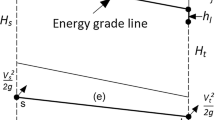Abstract
A subsurface drip irrigation system delivers water and nutrients directly to the plant root zone; other conventional nozzles-type or sprinklers-type irrigation are not used, and water-saving can reach 42–78%. In order to achieve this impact effectively, the drip irrigation requires a constant water supply under variations in pressure, which is so-called pressure compensating (PC) performance. The pressure compensating feature can be obtained by physical interaction between water flow and deformable silicone rubber in the PC dripper. In addition, pressure condition to ensure uniform water flow as a tresholding point also should be well designed, but it is generally have relied on the empiricial optimization. Here, we applied computational fluid dynamics to investigate water flow features in terms of flow rate and pressure drop of a conventional PC dripper. To understand the quantitative effects of changes in design parameters, we explored the fluid-structure interaction scheme in the CFD analysis between water flow and silicone rubber deformation. In this study, it is found that the marginal space for the silicone rubber deformation determined the threshold pressure condition; the friction condition of the tortuous channel of the dripper controlled the flow rate. This parametric study gave the logical insight to design new drip emitter with well-controlled and improved performance.
Similar content being viewed by others
Abbreviations
- G :
-
Shear modulus
- E :
-
Elastic modulus
- v :
-
Poission ratio
- P :
-
Pressure
- Q :
-
Volumetric flow rate
- R f :
-
Flow resist
- u :
-
Velocity
- A c :
-
Cross area
References
World Water Assessment Programme (Nations Unies), The United Nations World Water Development Report, New York, USA (2018).
C. R. Camp, Subsurface drip irrigation: a review, Trans. ASAE, 41 (1998) 1353–1367.
J. Narain and A. Winter, Determination of resistance factor for tortuous paths in drip emitters, Proceeding of ASME 2017 International Design Engineering Technical Conference and Computer and Information in Engineering Conference (2017) 67895.
G. Palau-Salvador, J. Arviza-Valverde and V. F. Bralts, Hydraulic flow behavior through an in-line emitter labyrinth using CFD techniques, Proc. of ASAE Annual Meeting (2004) 042252.
Y. Dazhuang, Y. Peiling, R. Shumei, L. Yunkai and X. Tingwu, Numerical study on flow property in dentate path of drip emitters, New Zealand Journal of Agriculture Research (2007) 705–712.
Q. Wei, Y. Shi, W. Dong, G. Lu and S. Huang, Study on hydrau-lic performance of drip emitter by computational fluid dynamics, Agricultural Water Management, 84 (2006) 130–136.
K. K. Oh, K. H. Ryu and S. H. Hong, Development of a computer simulation program of emitter discharges for trickle application, Journal of Biosystems Engineering, 20(4) (1995) 390–396 (in Korean).
Y. H. Kim, H. S. Choi, J. K. Kwon, K. H. Cho, H. S. Yun and D. S. Kim, A study on the improvement of the circulation dryer for rapeseed, Journal of Biosystems Engineering, 33(6) (2008) 390–395 (in Korean).
H. S. Yun, J. K. Kwon, H. Jeong, H. D. Lee and Y. K. Kim, Design of heat and fluid flow in coil container using CFD simulation, Journal of Biosystems Engineering, 33(6) (2008) 396–403 (in Korean).
J. H. Kim, M. H. Woo and D. E. Kim, Numerical and Experimental studies on the fluidic characteristics and performance of liner-type microtube, Journal of Biosystems Engineering, 42(1) (2017) 1–11.
M. Delghandi, M. Behzad, S. Broomandnasab and M. Saeedinia, Study on effects of temperature changes on emit-ters outflow of drip irrigation, Res. On Crops, 12(2) (2011) 600–606.
ANSYS FLUENT 2020 R2 in Workbench User’s Guide, ANSYS Inc., Canonsburg, PA (2015).
L. D. Landau and E. M. Lifshitz, Theory of Elasticity, Course of Theoretical Physics, 2nd Ed., Pergamon: Oxford, 7 (1970) 13.
Acknowledgments
This research was supported by the Agenda Project of the Rural Development Administration (Development of Weather Accident Response Technology) in 2021 (Project No. PJ01515 403).
Author information
Authors and Affiliations
Corresponding author
Additional information
WoongBhin Kang is an undergraduate student in Kyungpook National University (South Korea) for Bachelor degree in Department of Precision Mechanical Engineering.
SeolHa Kim graduated from POSTECH, for Bachelor (Mechanical engineering) to and Doctor degree (Nuclear engineering). He worked in Korea Atomic Energy Research Institute and Chinese Academy of Science for researcher. Currently, He is working in Kyungpook National University as an Assistant Professor.
Rights and permissions
About this article
Cite this article
Kang, W.B., Kim, J., Mo, H. et al. A fluid-structure interaction analysis of design factor of subsurface irrigation PC dripper. J Mech Sci Technol 36, 3469–3475 (2022). https://doi.org/10.1007/s12206-022-0624-6
Received:
Revised:
Accepted:
Published:
Issue Date:
DOI: https://doi.org/10.1007/s12206-022-0624-6




